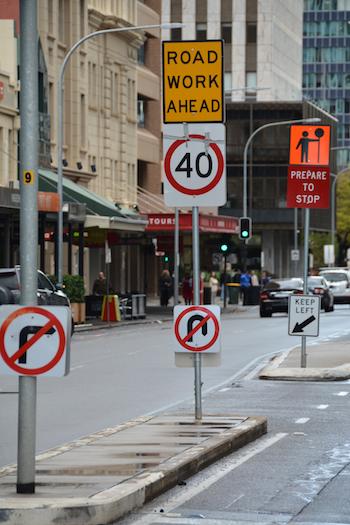Ready, set, go
Duration/age

Next time you are travelling in the car or going for a walk with your child, point out the different traffic signs. Why are they there? What do they tell you to do?
There are traffic lights outside the school. They tell us to slow down and drive at 25km.
As you notice the different signs try and sort or group them into ones that are the same.
Those are crossing lights. They help pedestrians to safely cross the road.
These ones are speed signs or speed limits. They tell the driver how fast they can go.
Materials you will need
- Street signs
- Traffic lights
Skills this activity improves
Why does this matter?
When children notice the different types of signs around them they are exploring the different ways we share and communicate language and information.Often we think of language as only spoken or written. Language can also be a picture or an image.
Signs help us to understand what to do or how to act. By noticing the different signs your child is learning that signs and symbols convey meaning in the same way that a written or spoken word can.
Talking together about what you have noticed on your travels helps your child to ask questions. As they notice objects they can group them and compare the differences. As they talk about what they notice they are developing language to describe their thinking and observations.
What does this lead to?
As children notice the different colours, shapes, images and how the image is placed on the sign they are developing an understanding that pictures and symbols can tell a story. We can change the story or message of what to do by adding other words, numbers or an image.
Talking about and exploring the natural and everyday environment with your child will help them to develop the skills to notice, take risks and ask questions. Even if your child does not have a natural disposition to be creative and curious, by exploring and posing questions you are helping your child to experiment with different ways of thinking.
Language to use
- Sign, traffic light, stop sign, railway crossing, speed limit
- Red, green, yellow, amber
- Stop, go, wait, caution, prepare
- Car, pedestrian, bike, bicycle, motorbike, bus, train, truck
- Signal, flashing, lights
- Intersection, level crossing, pedestrian crossing, overpass, walkway
Questions to use
- Do all cars have to wait at the red light?
- Do trains have to stop at the level crossing?
- Why doesn’t the ambulance need to stop at the red light?
- Where do you cross the road if there is no pedestrian crossing?
- Why do traffic lights have a yellow light?
- Do bike riders need to obey the traffic lights?
- What would you do if the traffic lights were flashing?
Useful tips
- You might also like to take a look at the activities What does that say? and Where should we park?
- Talk to your child about safety signs.
- Remember to talk to your child in your home language.
More ideas
- Take a camera with you on your search for signs. If you take a photo of ones that seem the same you can compare them later.
- Talk about where you are going and try to predict what signs you will see along the way.
Variation by age
Three to five year olds
- Make a book of signs.
- Take photos of the signs you see. Print them off and cut them out to use when playing with toy cars or building a city.
- Make dominoes or snap cards with the different photos you take.
- Time how long it takes for the lights to change colour.
- Count how many signs tell you to stop.
Questions to ask
- When you see a school crossing sign do you go faster or slower?
- Do all stop signs look the same?
- Why do some lights flash?
Language to use
- Same, different
- Fast, slow
- Stop, go


